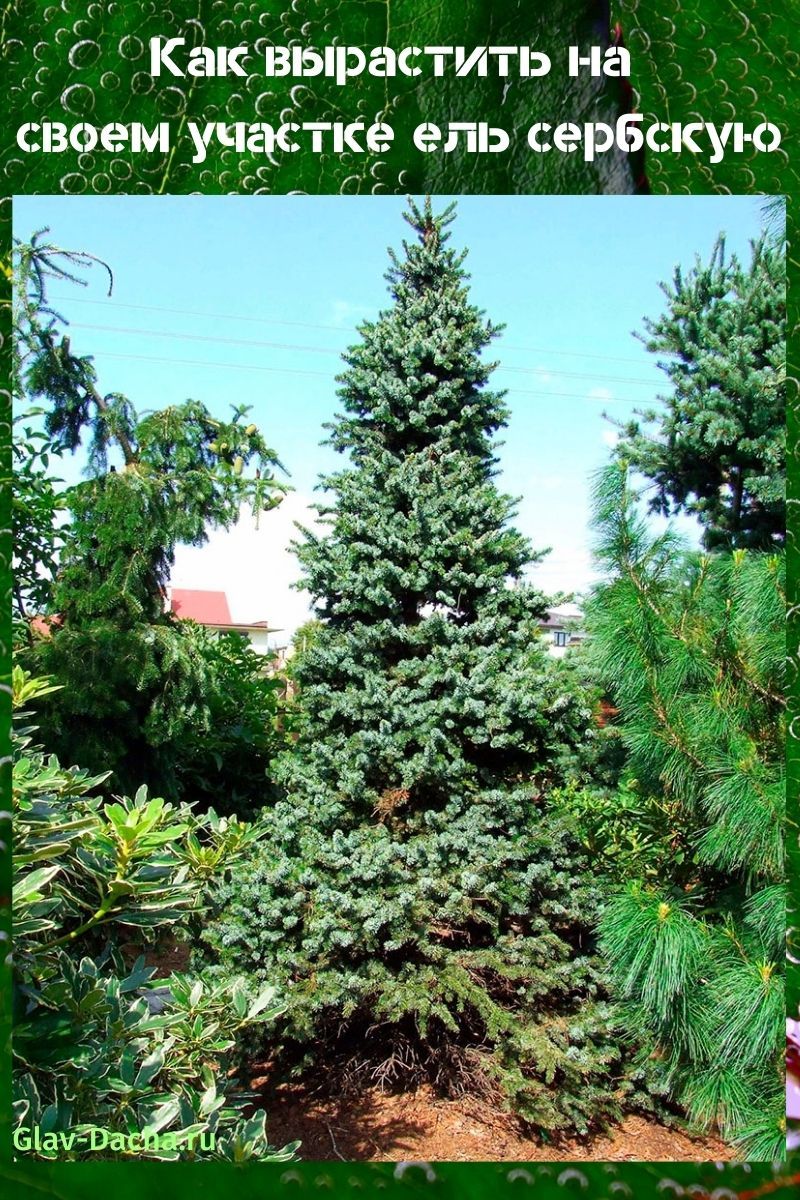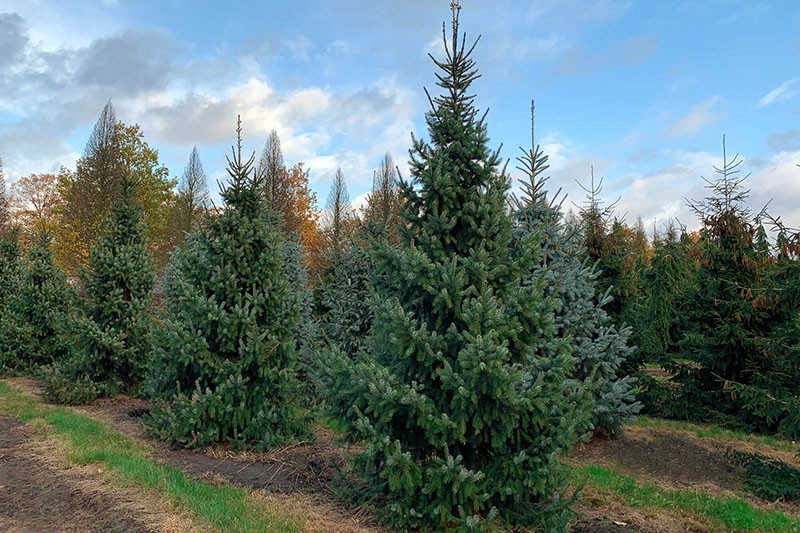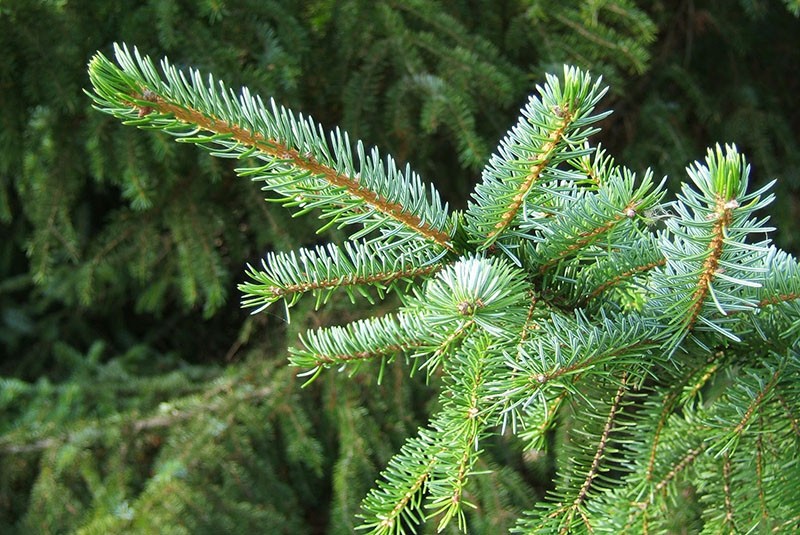How to grow Serbian spruce on your site
 Often the modest Serbian spruce is chosen by experienced designers for landscaping their backyard and urban areas. The main reason for choosing is amazing decorative qualities, unusual plant shapes, winter hardiness and unpretentiousness to the soil. According to biologists, today there are over 20 varieties of evergreens. Each of them blends harmoniously with deciduous trees, shrubs, lawn grass and flowers. Consider a detailed description of the Serbian spruce, as well as the most popular varieties of evergreen culture.
Often the modest Serbian spruce is chosen by experienced designers for landscaping their backyard and urban areas. The main reason for choosing is amazing decorative qualities, unusual plant shapes, winter hardiness and unpretentiousness to the soil. According to biologists, today there are over 20 varieties of evergreens. Each of them blends harmoniously with deciduous trees, shrubs, lawn grass and flowers. Consider a detailed description of the Serbian spruce, as well as the most popular varieties of evergreen culture.
Biological characteristic

The short side branches are not too high above the ground. They resemble an arc in shape, and the ends are directed upwards. Young specimens have a hanging structure and are covered with thick pile. All these elements form a columnar or narrow pyramidal crown. The top of the Serbian spruce is always pointed, which gives it a slender and presentable look.
 The branches are covered with tough needles. Its length reaches 18 mm and its width is about 2 mm. The surface of the needles is covered with a waxy bloom. The upper part of the needles is colored dark green, and the lower one has a silvery-bluish tint. It remains on the tree for 8 years. The flowering culture begins in May, after which cones are formed.
The branches are covered with tough needles. Its length reaches 18 mm and its width is about 2 mm. The surface of the needles is covered with a waxy bloom. The upper part of the needles is colored dark green, and the lower one has a silvery-bluish tint. It remains on the tree for 8 years. The flowering culture begins in May, after which cones are formed.
They differ in the following characteristics:
- oblong shape;
- length from 5 to 7 cm;
- the scales are tightly pressed, rounded.
 The cones are fully ripe by mid-autumn. At first they are purple-greenish. And later they acquire a dark brown shade with an ink sheen. In the wild, culture reproduces by self-seeding. It reaches full maturity by the age of 15.
The cones are fully ripe by mid-autumn. At first they are purple-greenish. And later they acquire a dark brown shade with an ink sheen. In the wild, culture reproduces by self-seeding. It reaches full maturity by the age of 15.
Serbian spruce easily tolerates cold, and can withstand frosts down to -35 ° C. Does not lose its decorative effect during temperature changes. The culture is resistant to strong and gusty winds. Feels comfortable both in the shade and in open areas.
Serbian spruce quickly adapts to loamy, rocky, sandy and podzolic soils.
Popular varieties
Taking the wild form as a basis, breeders have obtained unique plants. They have retained a high level of cold resistance. However, they acquired original decorative features. For example, they have a compact crown and grow only up to 7 m. Let's get acquainted with the most popular varieties of coniferous crops, which are grown in the middle lane.
Charming "Alexandra"
 A distinctive feature of the variety is the shape of the crown. It is an expanded cone up to 2 m wide. However, the annual growth of culture is only 3-4 cm. The first few years the crown has a rounded configuration. But later the crown is stretched out and it takes on the shape of a cone. The branches are decorated with needles of bright green color. Young needles have a slightly bluish tint.
A distinctive feature of the variety is the shape of the crown. It is an expanded cone up to 2 m wide. However, the annual growth of culture is only 3-4 cm. The first few years the crown has a rounded configuration. But later the crown is stretched out and it takes on the shape of a cone. The branches are decorated with needles of bright green color. Young needles have a slightly bluish tint.
Serbian spruce variety "Aleksandra" is used to decorate heather gardens, alpine slides and landscape compositions.
Dwarf variety "Nana"
 An adult culture grows up to 3 m in height.The crown consists of many graceful branches in the form of a plump skittle. However, for the first few years, the tree resembles a ball. Its width is about 2 m. The needles are painted in a greenish-gray color, and the reverse side has a silvery tint.
An adult culture grows up to 3 m in height.The crown consists of many graceful branches in the form of a plump skittle. However, for the first few years, the tree resembles a ball. Its width is about 2 m. The needles are painted in a greenish-gray color, and the reverse side has a silvery tint.
Up to 10 years, the annual growth of the culture is about 3 cm, and even then under ideal conditions. After this period, the growth rate increases. Therefore, in a year it grows by 10 cm.
Often the Serbian spruce "Nana" on the trunk is actively used to create a stylish landscape design. Thanks to this, the tree stands out effectively against the background of other plants. It is grown both in group and single plantings.
Graceful beauty "Karel"
 The variety is often included in the list of coniferous crops recommended for home gardens. She has relatively short branches, densely covered with dark green or light green, at a young age, needles. In the process of growth, the shoots form a rounded crown, resembling a volumetric pillow. Its diameter is about 100 cm.The height of the plant is about 80 cm.
The variety is often included in the list of coniferous crops recommended for home gardens. She has relatively short branches, densely covered with dark green or light green, at a young age, needles. In the process of growth, the shoots form a rounded crown, resembling a volumetric pillow. Its diameter is about 100 cm.The height of the plant is about 80 cm.
Serbian spruce variety "Karel" looks great in rock gardens, as well as against the background of creeping perennials.
The original variety "Pendula Bruns"
 The culture refers to slowly growing specimens. Differs in twisting falling branches that touch the soil surface. They form the original crown of a weeping configuration. A mature tree reaches a height of up to 10 m. The annual growth is about 10 cm. The Bruns variety in standard form looks truly magnificent against the background of other horticultural crops.
The culture refers to slowly growing specimens. Differs in twisting falling branches that touch the soil surface. They form the original crown of a weeping configuration. A mature tree reaches a height of up to 10 m. The annual growth is about 10 cm. The Bruns variety in standard form looks truly magnificent against the background of other horticultural crops.
As you can see, the given varieties of coniferous plants indicate its versatility. Thanks to this, designers actively use culture to create original landscapes.
We grow Serbian spruce at their summer cottage
 Since ancient times, conifers have attracted the attention of gardeners. They not only wonderfully fit into the territory of a country house, but also purified the air. In addition, stylish trees have a beneficial effect on the emotional state of a person. Let's try to understand the principles of planting Serbian spruce and caring for it at their summer cottage.
Since ancient times, conifers have attracted the attention of gardeners. They not only wonderfully fit into the territory of a country house, but also purified the air. In addition, stylish trees have a beneficial effect on the emotional state of a person. Let's try to understand the principles of planting Serbian spruce and caring for it at their summer cottage.
Observation of the plant has shown that it takes root wonderfully on any kind of soil. However, the tree does not like wetlands.
If there is clay and dense soil on the territory intended for planting, a drainage layer is placed on the bottom of the planting pit using any of the materials:
- expanded clay;
- coarse sand;
- crushed stone;
- broken brick.
 Its thickness should be at least 20 cm.As a rule, a funnel is dug with a depth and width of about 60 cm.If several specimens are planned, the distance between them is 2.5 m. Add to the soil humus, peat and sand. To speed up the process of crop development, complex fertilizers are applied. Then the seedling is carefully placed in the hole so that the root collar is at the level of the soil. The resulting voids are filled with the resulting substrate. The upper ball is lightly tamped and watered abundantly.
Its thickness should be at least 20 cm.As a rule, a funnel is dug with a depth and width of about 60 cm.If several specimens are planned, the distance between them is 2.5 m. Add to the soil humus, peat and sand. To speed up the process of crop development, complex fertilizers are applied. Then the seedling is carefully placed in the hole so that the root collar is at the level of the soil. The resulting voids are filled with the resulting substrate. The upper ball is lightly tamped and watered abundantly.
Serbian spruce is planted in the Moscow region in spring or early autumn.
Basic rules of care
 Young specimens need moisture throughout the season. Otherwise, the fragile roots will lose strength and dry out quickly or their needles will turn yellow. 10 liters of water is enough for one tree. After watering, the near-stem area is gently loosened. In hot periods, the upper part of the crown is sprayed with a spray bottle.
Young specimens need moisture throughout the season. Otherwise, the fragile roots will lose strength and dry out quickly or their needles will turn yellow. 10 liters of water is enough for one tree. After watering, the near-stem area is gently loosened. In hot periods, the upper part of the crown is sprayed with a spray bottle.
 The rules of care include sanitary pruning. If necessary, the crown of the Serbian spruce is cleaned of dried, broken and frozen branches. The shaping haircut is done in winter when the culture is at rest. In this case, only 3-4 cm are cut at a time.
The rules of care include sanitary pruning. If necessary, the crown of the Serbian spruce is cleaned of dried, broken and frozen branches. The shaping haircut is done in winter when the culture is at rest. In this case, only 3-4 cm are cut at a time.
 Despite the high winter hardiness, an additional shelter is built for seedlings under 5 years old. Usually any "breathable" material is used, for example, thin burlap.The near-trunk layer is covered with mulch from needles or sawdust. If there is a lot of snow in winter, it is gently shaken off the branches.
Despite the high winter hardiness, an additional shelter is built for seedlings under 5 years old. Usually any "breathable" material is used, for example, thin burlap.The near-trunk layer is covered with mulch from needles or sawdust. If there is a lot of snow in winter, it is gently shaken off the branches.
To protect the tree from parasites, the crown is sprayed with soapy water, a decoction of onion peels or an infusion of garlic.
It turns out that a pretty Serbian spruce is easy to grow in a summer cottage. Gardeners first choose a suitable variety. A planting pit, a nutrient substrate are prepared, drainage is laid. They carefully place the tree and cover it with earth. They look after according to the rules of agricultural technology.